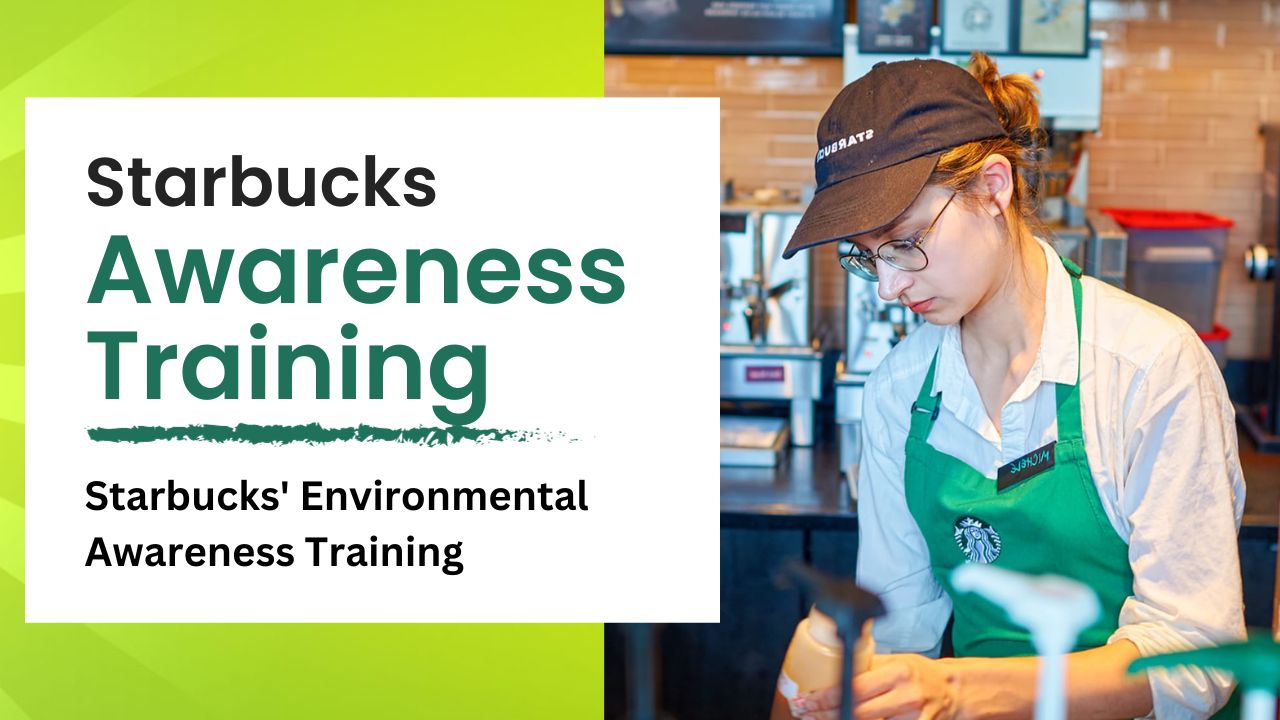Sustainability in Sips: Starbucks’ Environmental Awareness Training

Starbucks’ commitment to the environment extends beyond just serving coffee; it is woven into the very fabric of the company’s operations. Recognizing the significant impact of the coffee industry on the environment, Starbucks has taken proactive steps to integrate sustainability into every aspect of its business. Starbucks includes comprehensive environmental awareness training for its employees, known as partners. By dedicating Starbucks partner hours to this training, the company ensures that its workforce is not only skilled in coffee-making but is also environmentally conscious. Additionally, Starbucks’ environmental commitment reflects its understanding that a sustainable future is essential for the company’s long-term success.
Starbucks’ Vision for a Sustainable Future
Starbucks envisions a future where its operations harmonize with the environment, contributing positively to the planet. The company’s sustainability vision is ambitious, aiming to reduce its carbon footprint, conserve water, and minimize waste. This vision is communicated to employees through targeted training, emphasizing the role they play in achieving these goals. Furthermore, By investing in My partner hours for sustainability education, Starbucks empowers its employees to make environmentally friendly decisions in their daily roles.
The Importance of Environmental Awareness in the Coffee Industry
Environmental awareness is increasingly important in the coffee industry, given its global scale and impact. Starbucks recognizes this and has made environmental training a core part of its business strategy. The training covers various aspects, from sustainable farming practices to waste reduction in stores. Understanding the Starbucks gift card balance is more than just a financial transaction; it represents a commitment to sustainable practices. Starbucks’ focus on environmental awareness reflects its understanding that the health of the coffee industry is intrinsically linked to the health of the planet.
The Genesis of Starbucks’ Sustainability Training
Starbucks’ journey towards sustainability training began with a deep understanding of the environmental impact of the coffee industry, which includes Starbucks’ Coffee Knowledge Workshops and Mastering the Art of Espresso Presentation. Recognizing the need for change, Starbucks initiated a comprehensive program aimed at reducing its ecological footprint and promoting sustainable practices. This program marked the beginning of a transformational journey, embedding environmental consciousness into every aspect of the company’s operations. The training is not just a corporate responsibility; it’s a reflection of Starbucks’ commitment to a healthier planet. Finally, This initiative is a testament to Starbucks’ dedication to leading the industry towards a more sustainable future.
Evolution of Environmental Consciousness at Starbucks
Starbucks’ environmental consciousness has evolved significantly over the years. Initially, the focus was on basic recycling and energy conservation practices. However, as the company grew, so did its understanding of the broader environmental issues. Starbucks’ sustainability training program evolved to include complex topics such as ethical sourcing, carbon footprint reduction, and water conservation. This evolution reflects Starbucks’ commitment to staying at the forefront of environmental stewardship in the coffee industry.
Implementing Sustainability in Corporate Culture
Internal Policies Promoting Sustainability
Starbucks has implemented a range of internal policies to promote sustainability. These policies cover everything from reducing waste in stores to ethical sourcing of coffee beans. The company has set ambitious goals for itself, such as achieving a 50% reduction in water use and becoming resource-positive. This commitment to sustainability is ingrained in the corporate culture of Starbucks, influencing decisions at every level of the organization.
Partnering with Environmental Experts for Training Development
To develop its sustainability training program, Starbucks has partnered with leading environmental experts. These collaborations have ensured that the training is based on the latest scientific research and best practices in environmental stewardship. The experts help Starbucks understand the complexities of sustainability and how best to implement these practices in a corporate setting. Additionally, This partnership is a crucial element in the success of Starbucks’ sustainability training program, ensuring that the company’s efforts are effective and impactful.
Core Components of Environmental Awareness Training
Starbucks’ Environmental Awareness Training, along with Customer Service Training at Starbucks and Training on Starbucks’ Digital Tools and Platforms, is integral to its commitment to sustainability. This training encompasses a broad range of topics, each aimed at reducing the company’s environmental footprint and promoting eco-friendly practices among its employees and customers. It covers the global impact of coffee production, innovative waste management strategies, and ways to reduce the company’s carbon footprint. This comprehensive training approach ensures that Starbucks’ staff are not just skilled in making coffee but are also stewards of the environment. The company believes that educating its employees is the first step towards meaningful environmental change.
Understanding Environmental Impact
Understanding the environmental impact of coffee production and its related activities is a critical aspect of Starbucks’ Environmental Awareness Training. This training is designed to make employees aware of the environmental challenges associated with coffee production and the importance of sustainable practices. It addresses issues like deforestation, water usage, and biodiversity, and how Starbucks’ operations impact these areas. The goal is to foster a sense of responsibility and encourage actions that contribute to environmental sustainability.
The Global Impact of Coffee Production
- Coffee production significantly affects deforestation, especially in tropical rainforest regions.
- The industry is a major consumer of water, contributing to water scarcity issues in some areas.
- Coffee farming can impact local biodiversity, affecting ecosystems and wildlife.
- Understanding these impacts helps Starbucks in making informed decisions to mitigate negative environmental effects.
Starbucks’ Approach to Reducing Carbon Footprint
- Starbucks is actively working on reducing its carbon footprint across all areas of operation.
- The company focuses on energy-efficient practices and renewable energy sources in its stores.
- Sustainable sourcing of coffee and other products is a key strategy to minimize environmental impact.
- Starbucks is committed to achieving its goal of becoming a resource-positive entity, contributing positively to the planet’s well-being.
Waste Management and Recycling Initiatives
Waste management and recycling are pivotal components of Starbucks’ Environmental Awareness Training. The company aims to educate its employees about the importance of reducing waste, particularly single-use plastics, and implementing effective recycling practices. This training is essential in helping Starbucks achieve its waste reduction goals and move towards a more sustainable operational model.
Innovations in Packaging and Recycling
- Starbucks is pioneering new packaging designs to minimize waste and increase recyclability.
- The company is exploring compostable and reusable packaging options to reduce its environmental footprint.
- Efforts are ongoing to improve recycling practices both in-store and within the communities Starbucks serves.
- Starbucks is also engaging with suppliers and industry partners to develop more sustainable packaging solutions.
Reducing Single-Use Plastics
- Starbucks has taken significant steps to reduce the use of single-use plastics in its stores.
- The company is transitioning to more sustainable materials for straws, lids, and other plastic items.
- Starbucks encourages customers to use reusable cups and offers incentives for those who do.
- These efforts are part of Starbucks’ broader initiative to minimize waste and promote environmental responsibility.
Sustainable Sourcing and Ethical Practices
Starbucks recognizes that the cornerstone of its environmental strategy lies in sustainable sourcing and ethical practices. The company is committed to responsibly sourcing its coffee beans, ensuring that its impact on the environment is minimized. This commitment extends to working closely with farmers and promoting fair trade practices. By focusing on sustainable farming and biodiversity, Starbucks aims to protect ecosystems and the wildlife within them. These practices not only benefit the environment but also ensure the long-term sustainability of the coffee industry.
Ethical Sourcing of Coffee Beans
Building Relationships with Farmers
Starbucks believes in building strong, lasting relationships with coffee farmers. The company works directly with farmers to support sustainable agricultural practices. This collaboration helps farmers improve their yields and the quality of their coffee, while also ensuring they are fairly compensated.
Promoting Fair Trade Practices
Furthermore, Starbucks is a strong proponent of fair trade practices. The company ensures that the farmers are paid fair prices for their coffee, contributing to the economic stability of coffee-growing communities. This approach helps in creating a sustainable supply chain that benefits everyone involved.
Sustainable Farming and Biodiversity
Conservation Techniques in Coffee Farming
Starbucks promotes conservation techniques in coffee farming. These techniques include shade-grown coffee, which preserves natural habitats and biodiversity. The company also encourages practices that reduce soil erosion and water usage, contributing to the overall health of the environment.
Protecting Ecosystems and Wildlife
Protecting ecosystems and wildlife is a key part of Starbucks’ sustainability efforts. The company supports farming practices that maintain natural habitats and preserve local wildlife. By doing so, Starbucks helps to maintain the ecological balance in coffee-growing regions.
Read Related Posts:
Energy Efficiency and Green Stores
In its pursuit of sustainability, Starbucks places a strong emphasis on energy efficiency and the development of green stores. The company is committed to reducing its carbon footprint by designing eco-friendly stores and utilizing renewable energy sources. This commitment also extends to reducing water usage, with Starbucks implementing various conservation measures in its stores. Through these initiatives, Starbucks not only reduces its environmental impact but also sets an example for other companies to follow.
Designing Eco-Friendly Starbucks Stores
Energy-Efficient Store Designs
Starbucks is committed to energy-efficient store designs. These stores are built with materials that minimize environmental impact and are equipped with energy-saving appliances. The design of these stores reflects Starbucks’ commitment to sustainability.
Utilizing Renewable Energy Sources
Starbucks stores increasingly utilize renewable energy sources. This includes solar panels and wind energy, reducing the company’s reliance on fossil fuels. By incorporating renewable energy, Starbucks is leading the way in sustainable store operations.
Reducing Water Usage and Conservation
Water Conservation Measures in Stores
Starbucks implements water conservation measures in its stores. This includes using water-efficient appliances and encouraging practices that reduce water wastage. These measures are crucial in areas where water is a scarce resource.
Community Projects for Water Preservation
Starbucks is involved in community projects for water preservation. The company supports initiatives that aim to conserve water and improve water quality in coffee-growing regions. Ultimately, these projects not only benefit the environment but also the communities that depend on these water sources.
Empowering Employees and Customers
Starbucks understands that true sustainability can only be achieved by involving both employees and customers in its environmental goals. The company engages its employees in sustainability goals, offering incentives for green practices and providing regular training and workshops. Starbucks also encourages customer participation, educating them on sustainability and offering incentives for eco-friendly choices. Through these efforts, Starbucks hopes to create a broader impact on environmental stewardship.
Engaging Employees in Sustainability Goals
Incentivizing Green Practices Among Staff
Starbucks incentivizes green practices among its staff. Employees are rewarded for adopting sustainable habits, both in and out of the workplace. This approach encourages employees to be active participants in Starbucks’ environmental goals.
Regular Training Updates and Workshops
Starbucks provides regular training updates and workshops on environmental sustainability. These sessions keep employees informed about the latest sustainability practices and how they can contribute. The workshops also serve as a platform for employees to share their ideas on improving sustainability.
Encouraging Customer Participation
Educating Customers on Sustainability
Starbucks is committed to educating its customers on sustainability. The company provides information on how customers can make eco-friendly choices, both in their coffee purchases and in their daily lives. This education is an important part of Starbucks’ strategy to involve customers in its sustainability efforts.
Promotions and Incentives for Eco-Friendly Choices
Starbucks offers promotions and incentives to encourage eco-friendly choices among customers. Additionally, this includes discounts for customers who bring reusable cups or participate in recycling programs. Such incentives motivate customers to make sustainable decisions.
Starbucks’ Global Environmental Initiatives
Starbucks’ commitment to sustainability extends beyond its stores and into global environmental initiatives. The company collaborates with NGOs, government bodies, and other organizations to promote sustainability on a larger scale. Starbucks is involved in global campaigns and sustainability projects, focusing on areas such as climate change adaptation and environmental stewardship. These initiatives are part of Starbucks’ long-term commitment to setting new standards in the industry and continually improving its environmental impact.
Collaborations and Partnerships for a Greener Future
Working with NGOs and Governmental Bodies
Starbucks works closely with NGOs and governmental bodies on environmental projects. These collaborations help in implementing large-scale sustainability initiatives and in advocating for environmental policies. Starbucks leverages these partnerships to create a more significant impact on environmental conservation.
Global Campaigns and Sustainability Projects
Starbucks participates in global campaigns and sustainability projects. These projects cover a wide range of environmental issues, from deforestation to clean water initiatives. Ultimately, Starbucks’ involvement in these campaigns demonstrates its commitment to global environmental stewardship.
Challenges and Future Directions
While Starbucks has made significant strides in environmental sustainability, the company recognizes that there are ongoing challenges and room for continual improvement. Addressing these challenges, such as adapting to climate change and innovating new sustainability practices, is critical for Starbucks’ future. The company is committed to setting new standards in the industry and maintaining its ongoing commitment to environmental stewardship. Furthermore, these efforts reflect Starbucks’ dedication to not just being a leader in coffee but also in sustainable business practices.
Addressing Ongoing Environmental Challenges
Adapting to Climate Change
Climate change poses a significant challenge for Starbucks and the coffee industry as a whole. Starbucks is actively working on strategies to adapt to changing climatic conditions, ensuring the sustainability of coffee farming. This adaptation involves both mitigating its impact on the environment and helping farmers cope with the effects of climate change.
Continual Improvement and Innovation
Continual improvement and innovation are key to Starbucks’ approach to environmental challenges. The company is constantly exploring new ways to reduce its environmental footprint and improve its sustainability practices. Eventually, this commitment to innovation ensures that Starbucks remains at the forefront of environmental stewardship in the industry.
Starbucks’ Long-Term Sustainability Goals
Setting New Standards in the Industry
Starbucks aims to set new standards in the industry for environmental sustainability. The company’s long-term goals include achieving a circular economy, reducing waste, and becoming resource-positive. These ambitious goals are part of Starbucks’ vision to lead the industry towards a more sustainable future.
Ongoing Commitment to Environmental Stewardship
Additionally, Starbucks’ ongoing commitment to environmental stewardship is unwavering. The company understands that sustainability is a journey, not a destination. Starbucks is dedicated to continuing its efforts in environmental conservation, ensuring that it remains a responsible and forward-thinking leader in the industry.
Conclusion
Starbucks’ Environmental Awareness Training is a testament to the company’s deep commitment to sustainability and environmental stewardship. Through this comprehensive training, Starbucks equips its employees with the knowledge and skills necessary to make a positive impact on the environment. From sustainable sourcing of coffee beans to innovative waste management and recycling initiatives, Starbucks is leading the way in eco-friendly practices in the coffee industry. Furthermore, this dedication not only reflects the company’s responsibility towards the planet but also sets a standard for others in the industry to follow. Ultimately, Starbucks’ efforts in sustainability training are a crucial step towards a greener, more sustainable future for all.






